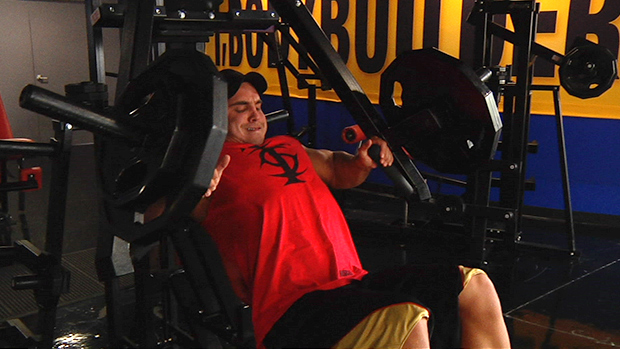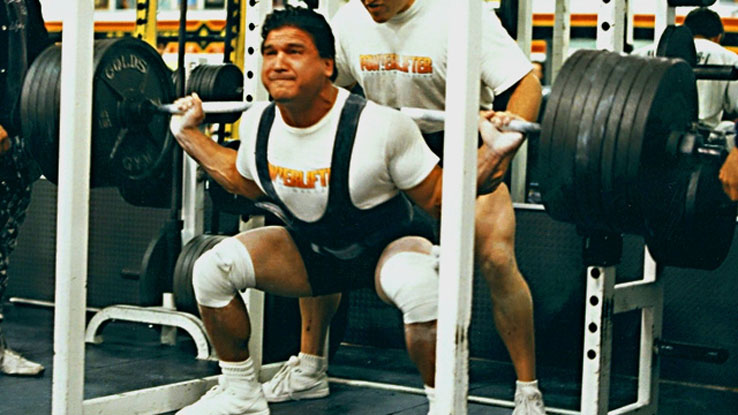The western region of Death Valley is home to one helluva enigma.
There, amid the motherless Joshua trees, are massive boulders that mysteriously slide across the desert. What's even stranger is that no one has ever seen it happen.
The only evidence is the path the gigantic rock leaves behind, as if someone parachuted into the desert, rolled the boulder up on a sled, and managed to pull it a half a mile without leaving a footprint. No one knows how or why a 700-pound chunk of rock can traverse a long stretch of barren land, but I'll be damned if it doesn't happen.
Another mind-blowing mystery is how William Hung got three record deals. That makes me scratch my head even harder than the Death Valley conundrum.
Other things, however, are easier to understand. Take High Frequency Training (HFT), for example. The idea that training more often can result in bigger muscles is pretty easy to comprehend because your body is designed to adapt to the demand that's placed on it.
But there's a trick to it. Well, there are actually a few tricks to make HFT work for you. And I assure you that no smoke, mirrors, or dancing rocks are required.
1. Get the Load Right
When you bump up the frequency of training, you've got to keep the training loads in check. Too much load and you'll burn out fast; not enough load and you won't see any results. Worse yet, you might turn your muscles into little endurance-loving specks of meat.
Training with a heavy weight is great for hypertrophy, but you've got to use enough volume. Three sets of three reps won't do much to make your muscles bigger, but eight sets of three with a heavy load will.
There's a problem, though. You can't do eight sets of three reps everyday. It's too taxing on your body. So the logical alternative is to use a light weight and do a bunch of reps every day.
This strategy is fine for the calves and deltoids, but not much else. Your other muscles tend to shrink when high endurance demands are placed on them. That's why there's got to be a delicate balance between load and volume. It's like Goldilocks and her porridge.
The best method I've found is to start with a load you could do 6-10 times. For some people, this might mean a body weight pull-up. That's great because the less equipment you need, the more likely it is you'll stick to the plan, as I'll discuss later.
Anyway, you'll do one set every day, as far away from your workout as possible. So if you train in the morning, do your HFT exercise at night, or vice versa. On the days you don't do your normal weight workouts, the time you choose for your extra exercise doesn't matter.
2. Progress When You Can
I'm a stickler for progression methods. After all, you'll never get great results unless you constantly force your body to do more work. But when you start doing an exercise every day, things can get a little wacky.
Most people could stand to improve their chin-up numbers and add some upper arm and upper back mass in the process, so I'll use the chin-up as an example.
Let's say you can do no more than eight pull-ups with perfect form. That's a perfect load for the HFT method. Each day you'll do one set of chin-ups for as many reps as possible. Importantly, this is in addition to the other upper back and arm workout you're doing in your other workouts. In other words, just because you chose the chin-up as your HFT exercise doesn't mean you can't do chins or pull-ups in your main workouts.
So you start doing the chin-up everyday. Day 1 is fine. So are days 2 and 3 since you were able to add a rep. But after six or seven days you might lose a rep. Two days later you might gain two reps. Then you might lose a rep, gain a rep, lose another rep, and gain two reps over the course of four days.
The good news is that it doesn't matter. The great thing about training with a high frequency — when hypertrophy is the goal — is the volume takes care of everything. Now that you're exposing your upper back and arms to significantly more volume each week, your body has no choice but to add muscle tissue. Just keep doing one set of the chin-up for as many reps as possible and you'll eventually see and feel the difference.
The goal with HFT is to steadily increase your exercise volume over time. That's why the rep progression is the best choice. It's simple and motivating to always try to beat your last performance by adding a rep — no complex load calculations required.
If on day 1 one you can 8 chin-ups, by the end of three weeks you should be able to do around 20, give or take a few.
Bottom line: add a rep whenever you can but don't worry if you lose a rep here or there. It's like the stock market: all that matters is that you end much higher than you started, regardless of the vacillations that might occur in between.
3. Make it Simple
Writing articles teaches me quite a few valuable lessons. One of the biggest lessons I've learned is to make things as user-friendly as possible. I've messed up on a few occasions, like the time I told TC to buy a top fuel Funny Car and take up drag racing to strengthen his anterior neck muscles.
In other words, if I recommend exercises that you can't do at home, it's going to be damn near impossible to do the exercise everyday. And I'll assume that all of you at least have a pair of dumbbells at home. If you don't, it'd be a wise investment. With that in mind, here are some good choices for HFT exercises for your lagging body parts:
Calves: single leg hop
Quads: single leg squat
Hamstrings and glutes: single leg dumbbell deadlift
Lats and upper back: wide grip pull-up
Biceps: chin-up
Triceps: triceps extension from plank *
Chest: push-up
Deltoids: standing dumbbell side raise
* Get in the plank position with your palms flat on the ground. Straighten your arms by pushing your body away from the ground. Lower and repeat.
Honestly though, it doesn't matter which exercise you choose as long as you can do no more than 10 reps on the first day. Just keep it simple.
Finally, limit your HFT exercises to 2-3 body parts. Doing a set of the push-up, chin-up, and single-leg hop each day is fine, but a total body HFT requires a completely different strategy, a strategy that I've outlined in my book, Huge in a Hurry.
4. Take a Break Every 3-4 Weeks
The goal with HFT for lagging body parts is to do the exercise 6-7 days per week for 3-4 weeks. By the end of that time your body and muscles will need a break. The cool part is that you'll likely gain more muscle in that time off as your body upregulates protein synthesis to the muscles you bombarded for the last month.
If the first month is for your calves, take 5-7 days off before you move to another body part. If you still need more calf mass, take 10-14 days off before you restart the process, using a different exercise.
That reminds me that there are some other random tidbits that I need to address.
Additional Points
First off, you don't have to use the exact same exercise everyday. Little variations in grip or foot placement can actually help. So if you choose the chin-up as your exercise you can cycle each day between a neutral- and pronated-grip pull-up. Or you could just stick to the chin-up.
Second, since the HFT workouts only take a few minutes, you don't really need to worry about any pre- or post-workout nutrition.
Third, make sure your form is perfect with every rep. Going from 8 strict pull-ups to 10 sloppy ones isn't progress.
Finally, depending on which exercise you choose, you might need to rig up something to make the load right. Let's say your chest is puny and you want to do a set of the push-ups as your HFT exercise. Assuming you can do more than 10 regular push-ups you'll need to make the exercise more difficult.
One way is to loop a resistance band around your upper back; another way is to elevate your feet; another way is to do the push-ups on a slick surface and slide your hands together with each rep (you'll need to place a small towel under your hands to make it work).
Regardless, I think you get the idea.
Start with an exercise that allows you 6-10 reps. Do that exercise everyday, in addition to your current training plan, and strive to triple or quadruple that number in a month.
By the end, you'll have new muscle to show for it!




